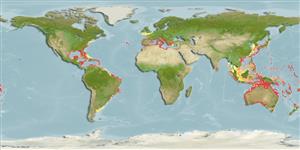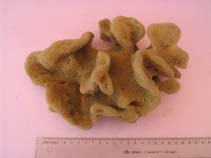Spongia officinalis Linnaeus, 1759
Greek bathing sponge| Native range | All suitable habitat | Point map | Year 2050 |

|
| This map was computer-generated and has not yet been reviewed. |
| Spongia officinalis AquaMaps Data sources: GBIF OBIS |
Classification / Names Common names | Synonyms | CoL | ITIS | WoRMS
| Dictyoceratida | Spongiidae
Environment: milieu / climate zone / depth range / distribution range Sinh thái học
; Mức độ sâu 5 - 76 m (Ref. 363), usually 5 - 40 m (Ref. 363). Subtropical; 46° - 25°
Sự phân bố Các nước | Các khu vực của FAO | Các hệ sinh thái | Những lần xuất hiện | Những chỉ dẫn
Mediterranean. Reports from the Indo-West Pacific, Caribbean must checked.
Length at first maturity / Bộ gần gũi / Khối lượng (Trọng lượng) / Age
Maturity: Lm ? range ? - ? cm
Short description Hình thái học
Sponge: variable; generally massive; round, but being able equipped with regular lobes (especially at the large specimens); or with large conical lobes osculus. Surface equipped with many small conules regular. Osculus: 0.3 to 1 cm in diameter; often raised. Primary fibers: 0.005 to 0.01 cm diameter; very few formed at their end in the conules by the anastomoses of several fibers; and containing some foreign bodies. The secondary fibers: 0.002 with 0.0035 cm of diameter; in tightened network sometimes finest close to surface. Coloring: color varying of the a little yellowish white to the black according to illumination, whitish with color of rust inside
Maximum size: Can exceed 35 cm in diameter. Depth: common between 5 m (under the overhangs) and 40 m; rare between 40 and 76 m. Importance: The fine sponge; used especially for the toilet, is exploited mainly in Greece, but with a weak production (Ref. 363). Found in the littoral areas particularly coral reefs with rock substrates (Ref. 82063). Common between 5 m (under the overhangs) and 40 m; rare between 40 and 76 m (Ref. 363). Filter-feeder (Ref. 68823).
Life cycle and mating behavior Chín muồi sinh dục | Sự tái sinh sản | Đẻ trứng | Các trứng | Sự sinh sản | Ấu trùng
Members of the class Demospongiae are hermaphroditic. Life cycle: The zygote develops into parenchymella larva (free-swimming) before settling down on a substrate where it grows into a young sponge.
Main reference
Các tài liệu tham khảo | Người điều phối | Người cộng tác
Vacelet, J. 1987. (Ref. 363)
IUCN Red List Status (Ref. 130435)
CITES status (Ref. 108899)
Not Evaluated
CMS (Ref. 116361)
Not Evaluated
Threat to humans
Human uses
Các nghề cá: tính thương mại cao
| FishSource |
Các công cụ
Thêm thông tin
Các nước
Các khu vực của FAO
Các hệ sinh thái
Những lần xuất hiện
Những chỉ dẫn
Stocks
Sinh thái học
Thức ăn
Các loại thức ăn
Các khu vực của FAO
Các hệ sinh thái
Những lần xuất hiện
Những chỉ dẫn
Stocks
Sinh thái học
Thức ăn
Các loại thức ăn
Tên thường gặp
Các synonym ( Các tên trùng)
Các động vật ăn mồi
Sự tái sinh sản
Chín muồi sinh dục
Đẻ trứng
Sự sinh sản
Các trứng
Egg development
Các synonym ( Các tên trùng)
Các động vật ăn mồi
Sự tái sinh sản
Chín muồi sinh dục
Đẻ trứng
Sự sinh sản
Các trứng
Egg development
Các nguồn internet
BHL | BOLD Systems | CISTI | DiscoverLife | FAO(Publication : search) | Fishipedia | GenBank (genome, nucleotide) | GloBI | Gomexsi | Google Books | Google Scholar | Google | PubMed | Cây Đời sống | Wikipedia (Go, tìm) | Tạp chí Zoological Record
Estimates based on models
Preferred temperature
(Ref. 115969): 16.2 - 28.4, mean 25.4 (based on 1548 cells).
Price category
(Ref. 80766):
Unknown.



